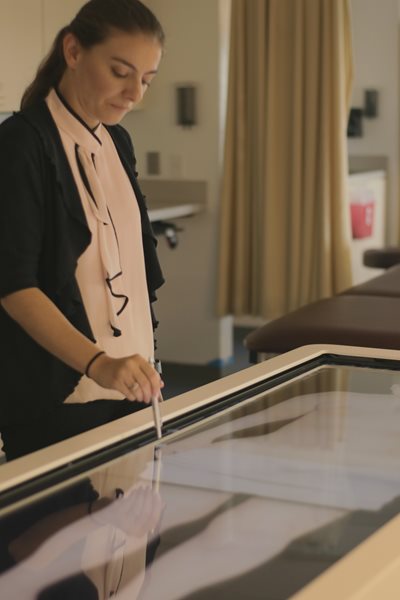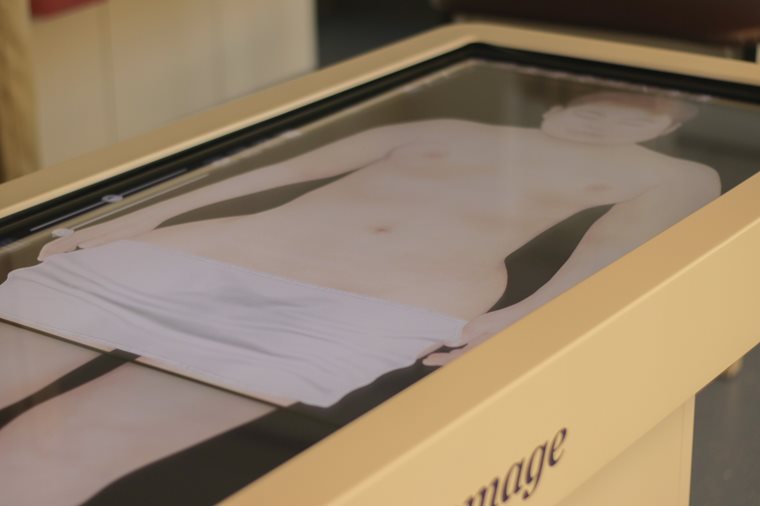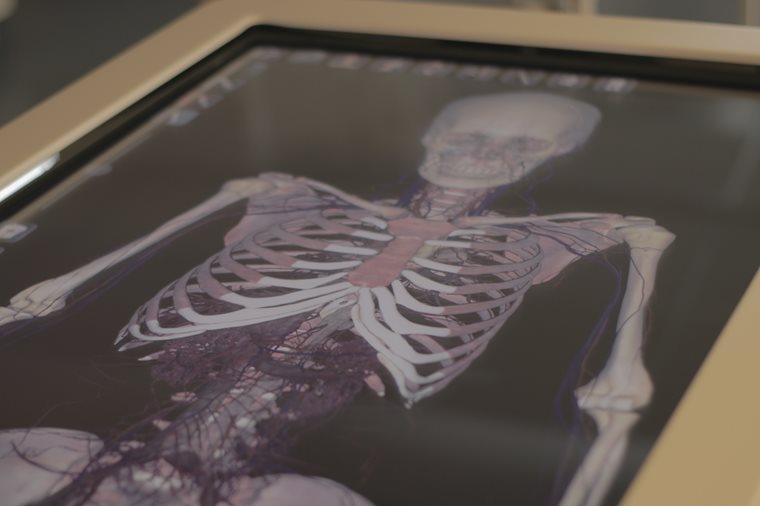 Students in the Physician Assistant program will eventually have the opportunity to supplement their training by having access to two 3-D anatomy simulators the University recently purchased. The simulators aren’t meant to replace time in the cadaver lab, but will be used to aid the students’ learning when they cannot be in the cadaver lab because, for example, the lab is being set up for an exam and not available.
Students in the Physician Assistant program will eventually have the opportunity to supplement their training by having access to two 3-D anatomy simulators the University recently purchased. The simulators aren’t meant to replace time in the cadaver lab, but will be used to aid the students’ learning when they cannot be in the cadaver lab because, for example, the lab is being set up for an exam and not available.
“The tables will be used to augment current anatomy instruction and provide means of review and remediation,” said Donna Agnew, MSPAS, PA-C, DFAAPA, director of the Physician Assistant (PA) program.
There are four full bodies loaded into the simulator – two females and two males. Each body is complete and each has its own anatomical variations.
“People get excited about these digital anatomy teaching aids because not only are they very cool, but because there is a presumption that in an increasingly technologically sophisticated world, units like these will replace the cadaver as the principal means of teaching students gross anatomy. And that’s not true,” said Michael Speirs, associate professor of biomedical studies.
Speirs believes the machines will have a valuable role to play in PA education, as well as perhaps in some of the University’s other professional health programs.
“But the reality is that until what’s called haptic technology is developed, which involves the sense of touch in manipulating a virtual image or object, these units and these programs are primarily going to be useful in helping students review anatomy that they’ve learned about, either by performing dissection in the cadaver lab or by appreciating an actual dissected cadaver in the cadaver lab,” he said.
 The simulators have a variety of features. Students can utilize different scroll bars to move through parts of the body and can go through various sections layer by layer. There are scalpel tools to cut off sections of the body and thousands of CT scan images. Students can also divide the table into halves, with one part being for the body and the other being for the CAT scan image.
The simulators have a variety of features. Students can utilize different scroll bars to move through parts of the body and can go through various sections layer by layer. There are scalpel tools to cut off sections of the body and thousands of CT scan images. Students can also divide the table into halves, with one part being for the body and the other being for the CAT scan image.
“It allows the students to see where they are in the body and make the correlation to images on the scan,” said Christine McCormick, MMS, assistant professor in the PA program.
There are also histology sections in the simulators, so students can look at slides of a kidney or a colon, for example. There are also different features on the table that faculty members can access to set up a quiz where students can theoretically be loaded into the program and write down answers and turn them in.
The units contain four main data sets – a Caucasian male and female, who were scanned, sliced and digitized as part of the Visible Human Project, sponsored by the National Library of Medicine about 20 years ago. And then are two virtual Asians, a male and female, who were similarly scanned, sliced and digitized by the Korean Visible Human Project. That project was performed more recently and thus the level of resolution and detail in the Asian male and female are significantly greater than the two that came from the American Visible Human Project.
Faculty and students can not only manipulate the data sets in the tables, but they can add to them as well. For example, professor Speirs had an MRI done of his own head and neck and plans on downloading them into the system.
 “With a couple of simple commands, the system can generate a three-dimensional rendering of any radiographic data set that’s put in,” said Speirs. ”Students could be dissecting me. But more importantly, if we work with some of our clinical and hospital partners, we can theoretically acquire anonymized data sets from individuals of known diagnosis with clinically significant pathological anatomy. We could theoretically put that into the machine and create three-dimensional renderings and use that as the foundation for the type of learning exercises that we’d hope to develop for our students in the clinical year. This permits them to revisit their basic anatomical science and combine it with the clinical insights they’ve developed in the second year.”
“With a couple of simple commands, the system can generate a three-dimensional rendering of any radiographic data set that’s put in,” said Speirs. ”Students could be dissecting me. But more importantly, if we work with some of our clinical and hospital partners, we can theoretically acquire anonymized data sets from individuals of known diagnosis with clinically significant pathological anatomy. We could theoretically put that into the machine and create three-dimensional renderings and use that as the foundation for the type of learning exercises that we’d hope to develop for our students in the clinical year. This permits them to revisit their basic anatomical science and combine it with the clinical insights they’ve developed in the second year.”
At the moment, though, the machines aren’t available for student use.
“I think we’re in a stage in which faculty need to become familiar with the system, they need to become facile with the system, comfortable with it. The system is very powerful and we have to move beyond presenting pretty images,” said Speirs. “What we are working on, and what we should be working on, is development of curriculum. We want the faculty to first get some hands-on experience with the table, and learn the power of the table.”
In the meantime, plans are proceeding on having the students use these tables as soon as possible.
“Real cadavers provide a level of learning that you just can’t replicate,” said McCormick. “The goal is to use it as a supplemental tool so that students can have more exposure to the anatomy.”
“Most people spend a lot of money on these tables and never really unlock their power, never really learn how to use it to its fullest potential,” said Speirs. “We certainly plan to do that here.”